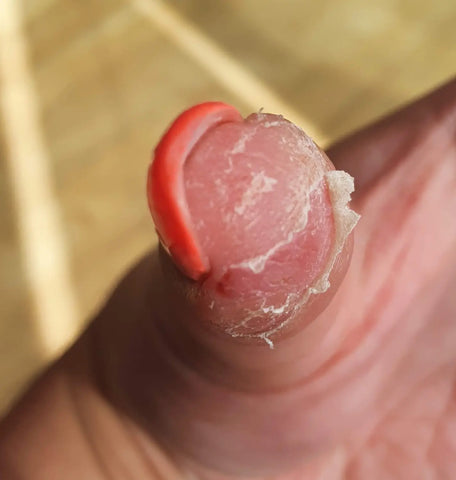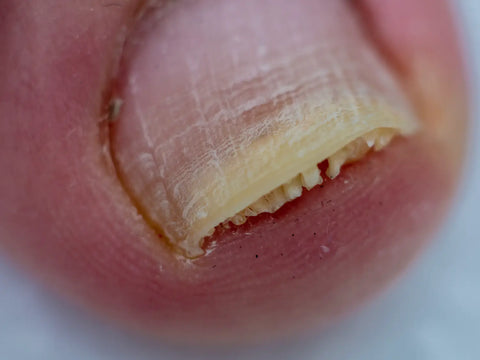Lets discuss every nail techs worst nightmare, allergies.
The first thing to say is its very important for nail technicians to remain calm and rational about the presentation of possible allergies. Someone may present with a contraindication that is not in anyway related to the nail products they have had on, we have to remember that we are not doctors and are not able to diagnose, we can simply advise. The worst thing you can do is jump straight to the assumption that the client is having a reaction and put fear into the client.
Common symptoms of a nail allergy, often resulting from exposure to ingredients in nail products such as gels, acrylics, or polishes, may include the following:
- Redness and Swelling: Red, swollen skin around the nail or on the fingers is a typical initial reaction. This inflammation may be a sign of an allergic response to an irritant.
- Itching and Burning: Intense itching or a burning sensation around the nail area is another common symptom. This can occur immediately after application or develop over several hours, even the next day.
- Blisters and Rashes: Small blisters or a rash may develop on the skin surrounding the nails. These blisters can be painful and may break, leading to further skin irritation and potential infection.
- Dry, Cracked Skin: The skin around the nails may become dry, cracked, and flaky. This can be particularly troublesome if the condition persists, leading to more significant skin damage.

- Nail Lifting: In severe cases, the nail itself may lift from the nail bed, also known as onycholysis. You may also see hyperkeratosis (thickening) of the nail bed.

- Pain and Tenderness: The affected area may become tender to the touch, and pain can be present even without direct contact. This is often due to the inflammation and irritation caused by an allergic reaction.
- Eczema-like Symptoms: For some individuals, the reaction may resemble eczema, with patches of red, scaly skin extending beyond the immediate area of the nail.
- Secondary Infections: If blisters or cracks in the skin are not properly cared for, they can become infected, leading to additional complications such as pus formation and increased pain.
- Secondary site reactions: Some people may have respiratory distress or even patches of swelling or redness at other locations on their body.
Due to the day and age we live in where there is a lot of scaremongering and misinformation it is very common for nail technicians to jump straight to the conclusion that something is an allergy when it could be many other things. In fact there is less of a likelihood for an allergy to occur than say a trauma, with an estimated 2.4% of people having a sensitivity to (meth)acrylates. This means that for every 100 people just 2.4 people may have an allergy and more commonly these allergies have come from exposure other than through recreationally having gel applied to their nails. Occupational exposure to dentists, nail technicians, healthcare and industrial workers makes up the majority of those affected by allergies to acrylates.
What are common contraindications you may see?
There are a plethora of contraindications that you may see that may cause you to jump straight to the assumption of an allergy to nail products but are something, completely unrelated such as:
Onycholysis: the lifting of the nail plate from the nail bed. This seems to be the contraindication most commonly misdiagnosed by nail technicians as an allergy. In fact onycholysis alone with no other accompanying symptoms, especially when isolated to one finger, is highly unlikely to be the sign of a reaction. It is far more likely to be as a result of a trauma to the nail but it can also be as a result of a fungal infection, psoriasis, eczema and lichen planus. Trauma to the nail can occur in many ways, not just hitting the nail plate hard, it can happen from repetitive strain from playing an instrument, a nail tip “pinching” the nail plate, exothermic reactions or catching the nail and bending it backwards. Often a trauma to the nail won’t even be remembered by a client.
Fungal Infection: Most commonly denoted by a slight discolouration to the nail, thickening of the nail and or nail plate and possibly lifting of the nail plate. Fungal infections and allergic reactions can very often look alike.
Skin Conditions: Skin conditions such as psoriasis and eczema look very similar to allergic reactions due to the changes in the appearance of the skin and nails.
Allergic reaction to something environmental: It is possible that a client presenting with signs of an allergic reaction is having a reaction to something else that they have been exposed to.
As you can see there are MANY reasons why someone, may present with a symptom and as a nail technician, we are not equipped to perform the testing that would be necessary to determine the underlying cause.
What should we do if a contraindication presents?
Its important not to be naive to allergies and understand that even if a client has had X on their nails 100 times they could react the 101st time having that treatment. If an allergy does present here are the steps you should take.
- Stay calm and logical and remember your training
- If it is safe to do so remove the nail enhancements gently and cut down the nails
- DO NOT apply any further enhancements until the client has seen a medical professional
- Refer the client to their GP who will assess the appropriate cause of action
What should we do if a client has a confirmed reaction to nail products?
An allergy can only be determined by dermatological testing where they will be issued with a report of the substances, they have had a response to, once they have had the report issued you should follow these steps:
- Report the confirmed reaction to your brand: whilst it’s a reaction is an individual’s immune response to something it didn’t like and it doesn’t mean there is anything wrong with the products, it’s still important for brands to have a note just in case they see any unusual patterns.
- Check SDS: If your client wants to continue to get nail enhancements you will need to work together to find a product that is suitable for them. This will require you to look closely through the SDS of products you may wish to try.
- Perform a patch test: As the client has a confirmed previous reaction they may develop allergies to other chemicals, when starting any new product isolate that to one finger and test for 48 to 72 hours to see if any reaction occurs. To be clear, this “patch test” should be performed using products that are free from the allergen that the client has a confirmed allergy to. Whilst you are using products on them that they haven’t previously had a confirmed reaction to, with clients who have a history of reaction it’s always important to take extra care.
- Be vigilant: Clients who have had reactions to products in the past are far more likely to react in the future, this could mean that they develop allergies to new chemicals over time. It’s important to make these clients aware that this is a possibility for them in the future and to report any unusual symptoms to you.
What can you do to reduce the chances of a reaction:
- Ensure your gels are properly cured: Under-cured gel can allow uncured monomers to be absorbed by the skin leading to overexposure over time.
- Avoid over-filing the nail plate: This is a common contributor to nail allergies as, like above, over-filed nails can allow monomers to be absorbed into the skin. If you over-file the nail and file through the dorsal layer, into the intermediate layer, this is where the nail turns to skin. Applying gel to the intermediate layer of the nail can allow monomers to be absorbed.
- Use professional-only products: Using high-quality, professional-only products from a brand you trust can help to ensure you can be sure of the provenance of the products.
Ultimately reactions are going to happen from time to time, but remember they are as a result of that individuals body having a response to something that it doesn't like and they can appear at any time to any thing.
@nailorder Let’s talk more about allergies within the nail industry!👩🏼🏫💅 #nailallergy #gelnails #hema ♬ Jazz in the Neighborhood (10 Minute Version) - Soap Radio.

